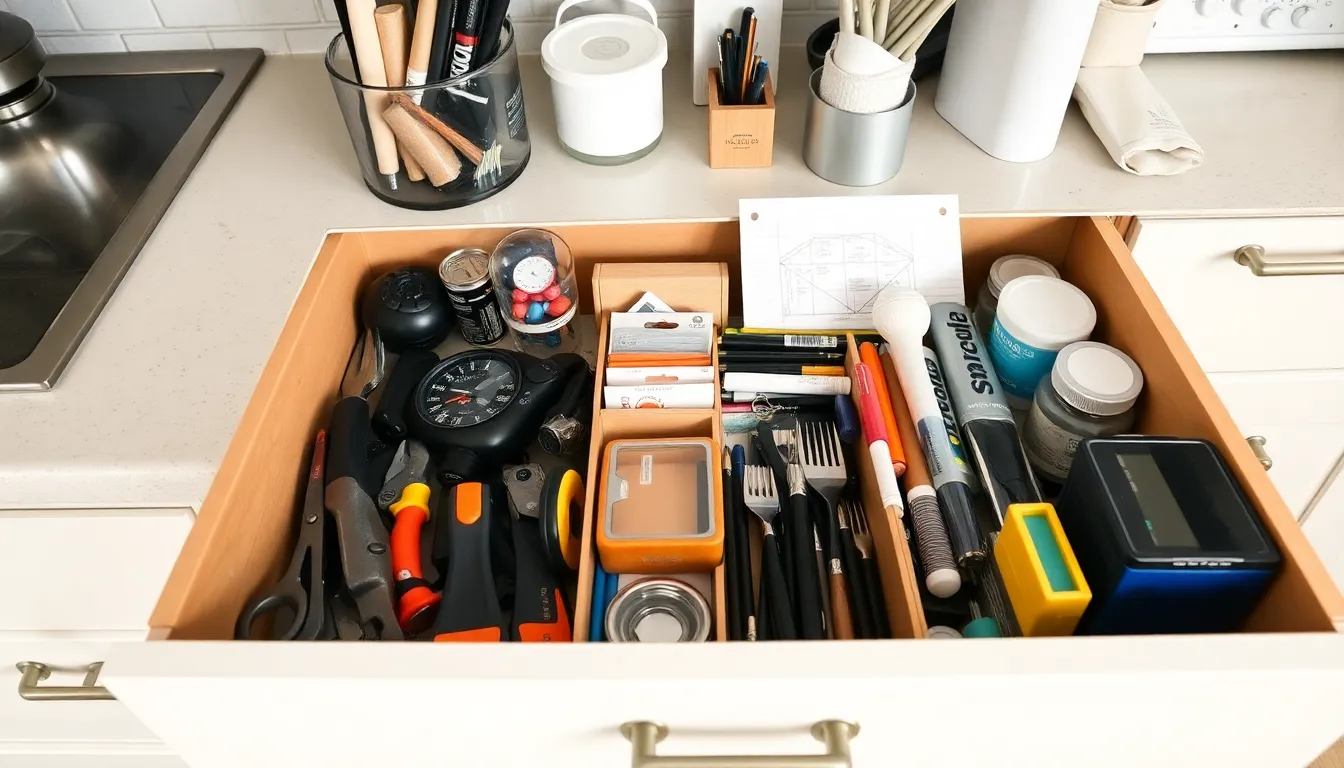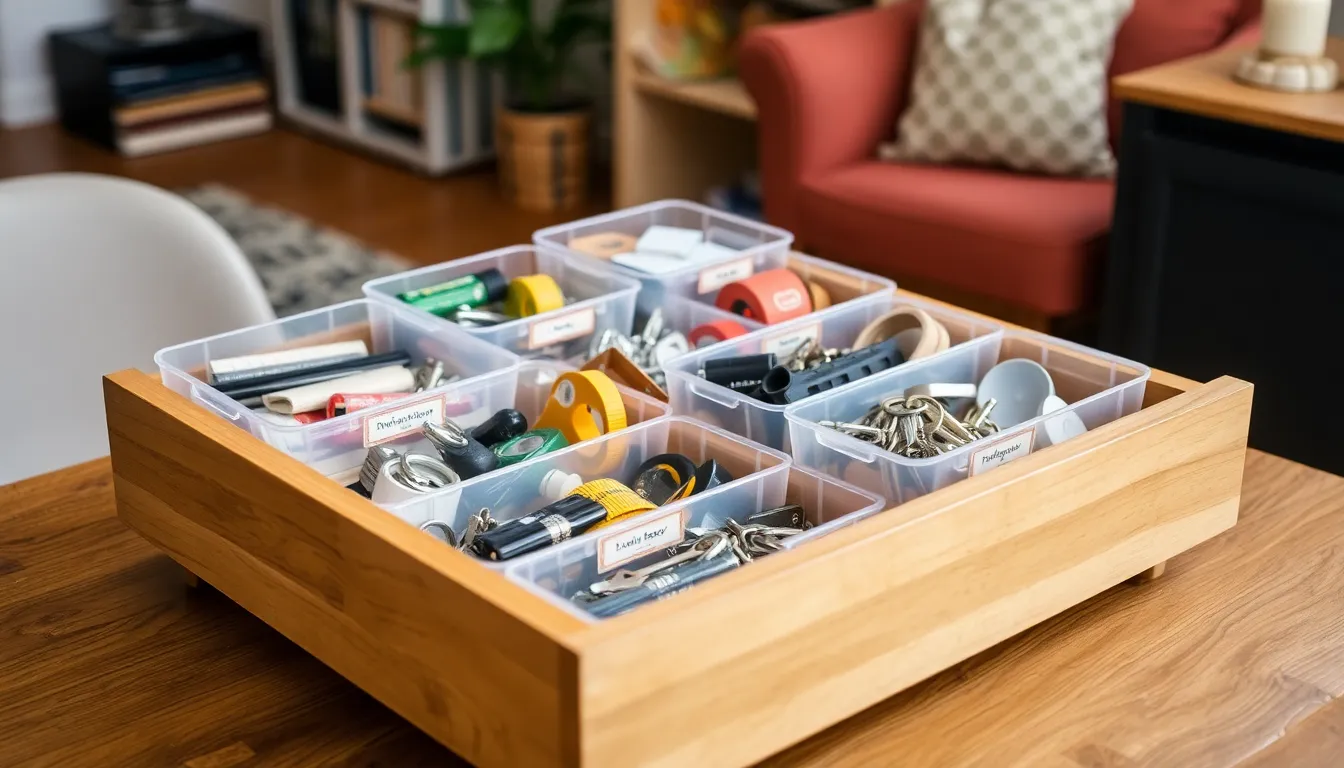Every home has that one drawer where chaos reigns supreme. It’s the Bermuda Triangle of household items—lost batteries, rogue tape measures, and mysterious keys that probably unlock something important. Organizing a junk drawer might sound like a daunting task, but it’s actually a chance to reclaim your space and sanity.
Table of Contents
ToggleWhat Is Junk Drawer Organization?
Junk drawer organization involves decluttering and systematically arranging the items stored in a junk drawer. This process allows for easy access to necessary items while eliminating clutter. Common items found in junk drawers include batteries, tape measures, keys, and miscellaneous office supplies.
Effective organization entails categorizing items based on their use and frequency. Grouping similar items together promotes efficiency, making it simpler to find what’s needed without rummaging. For instance, one can create sections for tools, stationery, and household items to enhance organization.
Choosing appropriate storage solutions is crucial. Clear bins or small trays can help compartmentalize items, allowing for a neater appearance. Labels provide additional clarity by indicating the contents of each compartment. This strategy aids in maintaining organization over time.
Regular maintenance is key to keeping a junk drawer ordered. Setting aside time every few months to reassess the contents can prevent clutter from building up again. Discarding outdated or unused items ensures only useful objects remain.
Understanding that organizing a junk drawer enhances not only functionality but also peace of mind is essential. By creating a structured environment within a commonly chaotic space, individuals can enjoy an organized home and save time. Implementation of these simple strategies can transform a junk drawer into a well-organized, practical storage solution.
Benefits Of Organizing Your Junk Drawer

Organizing a junk drawer offers multiple advantages that enhance everyday living. By tackling this common problem, individuals can achieve a more functional and efficient space.
Saves Time
Organized junk drawers enable quicker access to frequently used items. Previously misplaced batteries or tape measures become easily reachable. Searching for tools or supplies takes less time when everything is categorized. Streamlining this process reduces frustration during tasks like wrapping gifts or fixing objects. Simplifying access also minimizes disruptions, making day-to-day activities smoother.
Reduces Clutter
Reducing clutter within a junk drawer creates a more serene environment. Eliminating unnecessary items frees up space, allowing essential tools to stand out. An organized drawer minimizes visual chaos, making it easier to find what’s needed. Categories, such as tools and office supplies, enhance efficiency. Keeping only necessary items leads to a sense of accomplishment and well-being, improving overall peace of mind.
Essential Tools For Junk Drawer Organization
Effective junk drawer organization requires a few essential tools to streamline the process.
Storage Bins and Dividers
Storage bins and dividers play a crucial role in maintaining order. Clear bins allow visibility and easy identification of contents. Choose small, medium, or large bins depending on the items being stored. Dividers can separate different categories, such as batteries or tape, making retrieval straightforward. Consider adjustable dividers for flexibility; they adapt to changing storage needs. Organizing with bins reduces clutter and maximizes drawer space while keeping items accessible.
Labeling Supplies
Labeling supplies enhance organization significantly. Use label makers or simple adhesive labels for clarity. Clearly marked sections make it easy to locate items quickly. Choose waterproof or durable labels for longevity, especially in high-use areas. Consider color-coded labels for additional visual organization when categorizing items. Labeling not only supports efficiency but also encourages consistent maintenance by reminding users where everything belongs.
Step-By-Step Guide To Organizing Your Junk Drawer
Organizing a junk drawer requires a systematic approach. Follow these steps for an efficient transformation.
Emptying The Drawer
Start by removing all items from the junk drawer. Place the contents on a flat surface, such as a table or countertop, for easier assessment. Inspect each item thoroughly. Discard anything that is broken or no longer useful. This initial step clears the foundation for a well-organized space.
Sorting Items
Next, sort the items into distinct piles. Create categories like tools, office supplies, batteries, and miscellaneous items. Keep similar items together to simplify the next steps. Take moments to reconsider items you use infrequently; deciding whether to keep or discard them prevents future clutter. Maintain focus as you refine the collections.
Categorizing And Storing
After sorting, categorize items based on their purpose and frequency of use. Utilize clear bins and adjustable dividers to optimize space in the drawer. Label each container for easy identification and quick access. Store frequently used items at the front, ensuring that everything is visible and organized. Maintain this system by reassessing the drawer every few months to prevent clutter buildup.
Maintenance Tips For Sustaining Organization
Maintaining an organized junk drawer requires consistent effort. Regularly schedule a quick assessment every three months to keep clutter at bay. Evaluate item usage during this check; discard those that serve no purpose.
Create a simple system for returning items to their designated bins after each use. Encourage family members to adhere to this system to promote accountability. Keeping labels visible aids in quick identification of contents, making it easier to find necessary tools.
Utilize clear bins for easy visibility of items and to simplify the reorganization process. Categorize items based on frequency of use and need, allowing for seamless access to essentials. For frequently accessed items, designate a front position in the drawer, ensuring they remain within reach.
Consider using modular drawer organizers to adapt to changing needs or seasonal items. Transform the drawer layout as necessary to accommodate new supplies or tools that may be added over time. Group similar items together, such as office supplies and tools, to enhance organizational efficiency.
If the drawer becomes cluttered again, repeat the decluttering process. Focusing on functionality will streamline maintenance efforts in the long term. Ultimately, the goal is to create a space that remains practical and organized, providing convenience in everyday tasks.
Organizing a junk drawer transforms chaos into clarity. By taking the time to declutter and categorize items, individuals can create a functional space that enhances daily efficiency. With clear bins and labeled sections, finding essential tools becomes a breeze.
Regular maintenance is key to sustaining this newfound order. Scheduling routine assessments ensures that the drawer remains an asset rather than a burden. Embracing these strategies not only reduces frustration but also fosters a more serene living environment.
Ultimately, a well-organized junk drawer reflects a commitment to simplicity and functionality, making everyday tasks smoother and more enjoyable.







